Why use Web Push Notifications?
Online marketing is changing rapidly and new ways to interact with customers are continually being founded or improved. One innovative way to engage with customers is through the use of web push notifications. This article will give you some insights into what web push notifications actually are, how they are composed, and why to use them. To finish this article off, I will describe some use cases of web push notifications.
Quick Links
The first thing to know about those web push notifications is pretty obvious, it’s called a web push notification or a browser push notification because the notification is sent through a browser. That’s also the difference between a web push notification and an app push notification. An app push notification is sent by an app, a web push notification is sent by a browser. Next to that, you need to opt-in for web push notifications just like you need to give apps the permission to send you notifications. Via web push notifications you can send push notifications both mobile and desktop users, without having a mobile application.
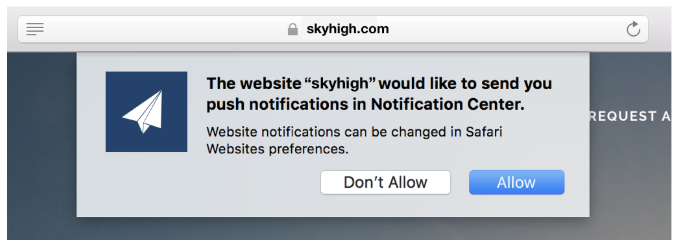
The anatomy of a Web Push Notification
What a web push notification looks like differentiates from provider to provider and between use cases, but usually, they have the same parts. Below will follow a quick explanation of all the parts.
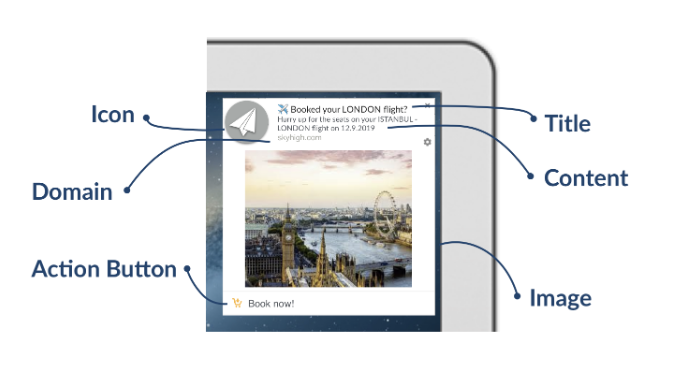
- Icon: Put your logo here to let everyone see it’s you.
- Domain: The domain from where the web push notification is sent.
- Action Button: This is a button with a call to action like ‘Book now’
- Title: This can be a name or a phrase, but not longer than one line.
- Content: This is the message and can’t be longer than two lines.
- Image: Here you can put an eye-catching picture.
The Benefits of Web Push Notifications
Okay so now you know what a web push notification is and what it consists of. But the next topic is why would you use them? There are multiple reasons, which I will explain below.
- Engage with Visitors After They are Gone
If visitors are browsing through your site and they’ve opted in to receive browser push notifications from you, you can reach them at any time. This is an advantage you do not see in any other web communications channel. That is a huge advantage no other web communications channel can offer.
Web push notifications offer the possibility that you can send notifications even after someone has closed your website. The messages will appear as notifications on the desktop or mobile device that the visitor is using. The visitor doesn’t even have to open his mailbox to see your notifications.
2. Timed Messages
Web push notifications can be sent at certain times. So it doesn’t matter if you want to send the notification straight away after the visitor left the site or wait for a couple of hours. With the character limit of a web push notification, it needs to be clear, short and powerful in contradiction to emails. Emails require a lot more thought and attention before sending them to your visitors.
Let’s say you want to let your visitors know that you have a sale, if you would do this through the email channel there is good chance the receiver of the mail will never see it. This is because the mail gets lost in between all the other mails the receiver gets or it lands in the unwanted mails tab. Web push notifications, on the other hand, lend themselves very good for sending such high priority and time-sensitive information. Web push notifications are delivered in real-time so If your users are connected to the internet, they will receive your notification as soon as you send it.
3. Higher Opt-in & Click-Through Rate
Different sources prove that browser push notifications produce better results in terms of opt-in and click-through compared to other marketing channels. Since browser push notifications only require the user to allow permission with just one click and users can unsubscribe at any time instantly.
Web push notifications have x3 higher opt-in rates than emails with opt-in rates ranging between 2–10% depending on the country, industry and type of website; while it is 2% for e-mails according to Sumo.
Web push notifications have x4 higher click rate than emails, with an average click rate of 8.5%, while emails have an average click rate of 2.4% according to Mailchimp.
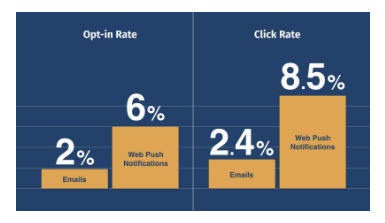
Web push notifications are being adopted by more and more companies worldwide. Therefore it’s getting increasingly important to understand the concepts and how to implement them to successfully generate traffic that keeps visiting your website.
- Re-engage with Users Who Don’t Sign-Up
There is no need to collect an email address or other contact details to communicate with your audience when using browser notifications. This is possible because web push notifications is a browser technology and therefore an awesome tool for website marketing.
It is also a great way of communicating with visitors who would probably never opt-in with email. Another advantage of this channel is that users can subscribe to push notifications very easily by just one click.
5. Supported the Leading Browsers, Systems and Devices.
Web push notifications work on the majority of leading browsers. These are Google Chrome, Mozilla Firefox, Opera, Microsoft Edge, and Safari. The notifications can be send through Google Chrome, Mozilla Firefox and Opera for all desktop and mobile devices. Microsoft Edge for Windows 10+ devices and Safari for Mac.
6. Low Effort, Big Returns
Push notifications are delivered instantly, so the engagement rate of users is higher compared to SMS or email. If you use a push notifications campaign that is put together well by sending personalised messages with interesting content, with the use of emoji and icons, you will be assured a much greater engagement than with the other tools. It’s good for push notifications are in a low effort and see big result any few minutes.
Use Cases of Web Push Notifications
Now that the benefits are clear, it’s time to talk about uses cases. Web push notifications are a tool that can be used by a lot of industries. There are a few industries though that lend themselves perfectly for web push notifications.
Cart Abandonment Notifications:
One of if not the most effective type of campaign for e-commerce. 3 quarters of all carts are abandoned at some point making it imperative that people are drawn back to the check-out process. Push notifications work better than emails in this case because there is no need for users to give information to send them a notification.
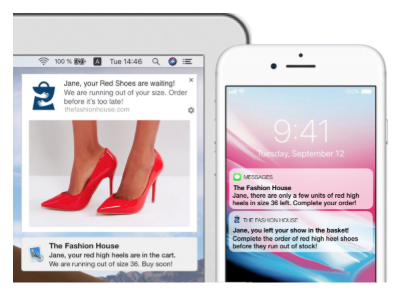
Search Retargeting Notifications
Another industry that can really profit from the web push notification channel in the travel industry. Start sending automated notifications to the users who searched for a trip, accommodation or tour at a destination but didn’t complete that booking.
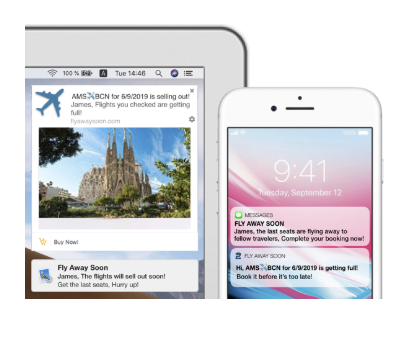
Periodic retention campaigns
Most valuable users are always returning users. Then you have to bring them back periodically for a good reason.
You can create automated campaigns to invite them periodically back to the website with some incentives that you can provide, such as discounts or coupon codes. But not only that, periodic retention also work for when for example new houses are added to your site.
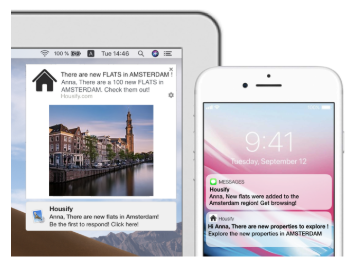
Final thoughts
Web push notifications are a great new retention tool and there are quite a few providers that offer a web push notification service. But, not every service is the same. There are a lot of services that offer manual send web push notifications which are great for a blog but not for an e-commerce company that needs more volume in notifications. For travel and e-commerce industries I would highly recommend a personalised and automated web push notification provider. If you would like to read more about web push notifications and how they can help you click here.
Author Bio
Robin Noordijk is a Marketing and Business Development specialist at Frizbit. Frizbit is a complete marketing platform for retention, based in Barcelona.
Twitter: https://twitter.com/frizbitpush
Facebook: https://www.facebook.com/frizbitpush
Linkedin: https://www.linkedin.com/company/frizbit
Website: Frizbit.com
Essential Skills for AI-Driven Digital Marketing
Digital marketing is changing a lot. Artificial intelligence (AI) is becoming really powerful and…
0 Comments10 Minutes
A Handbook for Crafting Outstanding Email Automation Plans
Email marketing is an essential tool for communication in digital marketing platforms. Managing…
0 Comments8 Minutes
Branding – What It Means for Your Business
Every single one of us has our own personal brand. Unique to each of us, this lies in who we are…
0 Comments5 Minutes
How to Create a successful SEO campaign, without an SEO agency
The quest for industry-leading SEO can be as financially draining as it is profitable. Despite its…
0 Comments8 Minutes
Safeguarding the Digital Realm: The Role of Machine Learning in Cybersecurity
The digital realm, an expansive network of interconnected devices and data, forms the foundation…
0 Comments8 Minutes
8 Strategies for Protecting Data and Preserving Brand Reputation
Processing and collecting sensitive data are now common practices as businesses depend more on…
0 Comments8 Minutes
Best Instagram Marketing Strategies For Small Businesses 2024
The number of Instagram users is projected to hit 1.4 billion globally by the end of 2024. This…
0 Comments14 Minutes
Friend or Foe for AI-Content? Decoding the March 2024 SEO Algorithm
The dynamic SEO environment continuously challenges marketers. The March 2024 update, cloaked in…
0 Comments8 Minutes
1 Comment
Comments are closed.









Wonderful experience gathered while I was going through your great article. Keep it up.